+971 2 6313010 | 631 3012
- Career
Five to nine years is the length of time most buyers plan to keep new home furnishings. With sofas, 36% of consumers say they’ll keep the product for five to nine years and 45% of mattress buyers plan to own a new mattress for that long. This timeline is also the case for the majority of consumers buying a new area rug.
These longevity stats hail from Furniture/Today’s 2016 Home Decorating Survey with the readers of online design source Apartment Therapy.
Wall décor buyers plan to own longer, with the majority saying they’ll keep their purchase 15 years or more. A full 28% of sofa buyers intend to own for 15 years or more, as do 14% of mattress buyers and 17% of new rug buyers.
The demographics of those planning to keep new furniture the longest vary by product. With sofas, households who earn $100,000 or more, Baby Boomers and those living in the Northeast are the most likely to use a new sofa for 15 years or more.
Our data also shows a high desire for quality product with 91% of consumers naming quality and durability as important aspects when purchasing a new sofa.
Affordability issues are a reality for many buyers seeking quality, however. As a 25-year-old buyer states, “It can be hard to find good quality without spending too much money.” “Affordable, quality furniture is difficult to find,” per a 40-year-old.

The choice depends on the need, but customised orders give you the liberty to tweak designs to suit your taste
The choice between going in for customised or readymade furniture is dependent on the needs of the customer. If there’s an urgent requirement while moving into an unfurnished home, readymade pieces usually come to the rescue. If the customer is on a time constraint; convenient and quick services would be the primary option. However, those who are looking for longevity will desirably take the time and choose high-end pieces to suit their taste and space requirements.
It is worth waiting to receive the exact, unique piece that fits the need and suits one’s personal taste. As any furniture may be a lifelong fixture, it’s vital that the piece is in sync with your style preference.
It’s essential to have the right design studio with creative heads, who have an eye for aesthetic beauty and are well versed with your choices. In this fast-paced world, customers look for convenience but bespoke customised products are designed to suit every inch of the room. This gives you the liberty to tweak the colours and sizes according to your preferences as opposed to readymade pieces. It is also important to note that with high quality furniture brands, you become an owner of a piece that will last for five-20 years, or even generations.
By customising a sofa for instance, you have the ability to make it your own sofa, unique to your specific needs.
Options of seating foams, fabrics, finishes are just some of the ways you can make your own piece.
Consumers today have easy access to a plethora of information online. They can compare, share thoughts and experiences online. They are much more aware of how and what to buy.
As for the demand for multipurpose furniture, it depends on your needs and lifestyle. If you live in a small studio, then of course a sofa-bed is required. Some people like to spend time and entertain friends in their open kitchens. Others spend a lot of time sitting on their sofas watching TV. In both cases, you might not need a dining room set. Counter bar with stools or big coffee table can be a good substitute.
The author is brand manager of the American furniture company, Ethan Allen.
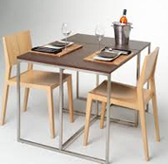
Steinhoff UK Bedding Group has invested £2.2m in a new Mercedes distribution fleet. The 14 new Mercedes Actros 1842 LS Euro VI compliant tractor units have been combined with 28 new bespoke trailers to create one of the most aerodynamic and fuel efficient vehicle fleets in the UK bedding industry.
Laurie Farley, Steinhoff Bedding Group’s logistics manager, is understandably proud of his new fleet, stating: “I have selected the Mercedes Actros tractor unit based on its unsurpassed performance credentials. The blue efficient diesel engine is the very best out there, and when combined with the Mercedes Stream Space airflow design generates the best fuel economy figures possible.
“As part of our investment we have introduced 12 bespoke ‘city’ trailers with rear steering axles specifically designed for deliveries to our growing independent customer base.”
All the new vehicles are fitted with satellite navigation, fridges and microwaves, and the drivers also get bespoke mattresses made by their Relyon brand. The entire fleet is managed by a GPS tracking system that plots the location of every vehicle in real time helping to ensure that the group’s beds are delivered on time and in full.
Steinhoff has plans for a further £1m investment in 31 additional trailers for delivery in 2017 and signals the group’s clear intention to become the UK's premier bed manufacturer.
Group CEO Anthony Joyce says: “We are delighted with the new vehicle fleet, and in particular our investment in supporting deliveries to our independent customers. Not only does this new fleet support our sustainable development programme, but it also helps us to become more efficient on a number of levels.”
Steinhoff UK Bedding Group manufactures mattresses, divans and headboards from its two core bedding sites based in Wellington, Somerset and Huntingdon, Cambridgeshire. Its portfolio brands include Dunlopillo, Myer’s, Relyon, Slumberland and Staples.
Textile designer Melanie Brooks’ Sit & Play Cooker combines function and fun, being both a children’s chair and a fun and educational item for play. Melanie's aim is to create fun and commercial yet clever designs that never compromise on quality.
Melanie studied Fashion and Textile Design with Business Studies at the University of Brighton. She has also taken a traditional upholstery course at the Upholstery Skills Centre in Stapleford Abbotts.
Melanie spent 13 years as a women’s knitwear designer working for labels such as Nicole Farhi, Ghost and Marks & Spencer before pursuing her love of textiles. She received a pass with distinction from the Association of Master Upholsterers and was a finalist in the national Heico Design Competition.
Melanie explains the concept behind her Sit & Play Cooker: “When given a small chair and a brief to be as creative as possible, I knew I wanted to design a children’s chair with a twist. The chair is upholstered in brightly-coloured vinyl for fun and practicality. I was inspired by my daughter’s wooden toy cooker and the chair being child size in proportion – I wanted to create a chair that my children could both sit and play on. The chair has turning cooker knobs and moving clock hands to make it educational, plus removable and magnetic soft vinyl utensils.”
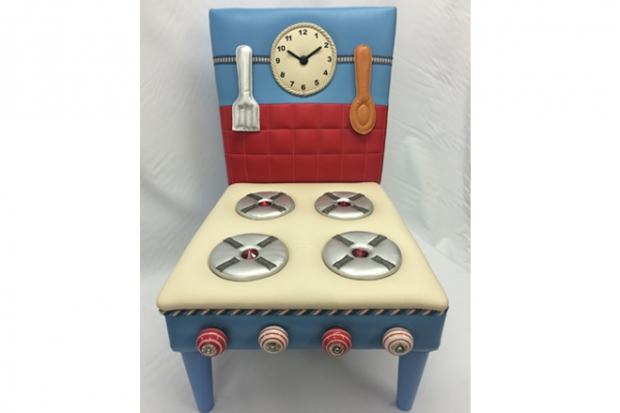
Furniture remained at seventh position in the growth rankings table, recording its worst performance in over two years. A reversal of last month’s trend, Store sales experienced faster growth than Online Furniture sales, resulting in a 1.1 percentage point fall in the online penetration rate to 27.7%.
Online sales represented 20.6% of total non-food sales in the UK, against 19.8% in June 2015.
BRC chief executive Helen Dickinson OBE says: “Online sales growth slowed to 9% this month. While lower than last month’s growth it remains a solid performance, considering that June 2015 had recorded the best growth of that year. Online sales grew across all categories except Footwear and increased their share of total non-food sales as stores sales slipped further into negative territory.
“While online clearly remains the primary driver of sales growth for UK retailers, shoppers are no longer thinking in channels and are more and more often using both digital and physical stores as part of their customer journey from initial consideration to the actual transaction. Today’s figures re-emphasise the need for physical stores to be a destination for retail experiences rather than specifically and solely for the sales transaction itself.”

With over a century of mattress manufacturing expertise, Kaymed is a leading innovator in gel and visco-elastic technologies, and its Therma~Phase material, which contains patented phase-change gel crystal technology, has become one of market’s most popular temperature control solutions – UK sales manager Terry Bridger explains …
Why is temperature control the mattress world’s hot topic?
Thermally-regulating mattresses have taken the US market by storm, and have clearly captured the imagination of UK consumers – and some manufacturers alike – since we advertised Therma~Phase in our 2015 winter sale TV consumer campaign.
However, there are actually several different types of materials in the market that either have no actual thermal properties or are designed to cool rather than being thermally regulating.
We have noticed a massive increase in manufacturers claiming that they are using foams that have “highly breathable” open cell constructions. The fact is that no actual claims of temperature regulation are being made. In short, they will simply claim that their existing, long-established Foam A is cooler than a certain generic Foam B, and are therefore attempting to align their product to the bigger – and frankly infinitely more remarkable – story by association.
Foams with actual cooling properties can be latex, polyurethane or memory foam based, and will generally fall into the following categories: foams infused with good conductors of heat; those washed through with a gel solution; foams with a gel layer attached to the surface; and Kaymed’s iKool and Response Gel, which are infused with our proprietary gel crystals.
Irrespective of how well these materials may work, this is in essence a one-way cooling process, in that the additives to the foam are there to conduct heat away from the mattress surface. Therefore, the reality is that these all have a ‘cooling technology’ story, rather than a temperature regulating one.
Therma~Phase contains phase change gel crystals that are designed to store and release heat at predetermined levels, and is thus able to regulate the mattress surface temperature. Temperature is maintained via the infinitely reversible phase change abilities of the material, as it absorbs or releases heat when it is in contact with a body and the surface temperature is higher or lower than the target temperature range
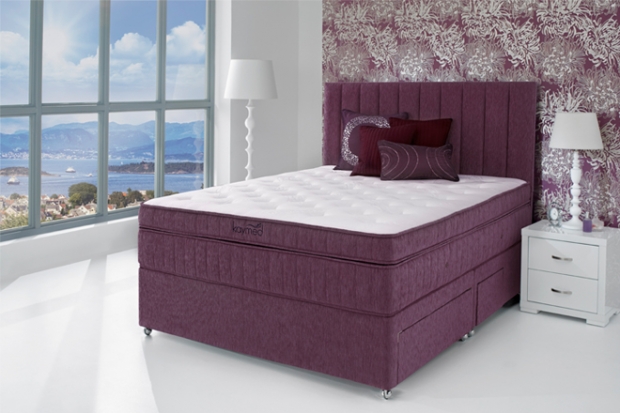
Our vision at The Furniture Makers’ Company is to create a wide ranging education programme that will help to support and nurture young talent for the future. With multiple avenues available through both academic and vocational education, it is important that our educational initiatives are diverse and wide ranging in order to support to as many young people as possible.
The Young Furniture Makers is the student facing brand that encompasses our all of our educational efforts. It is a free to join group open to all young people, run by our student members. It provides them with valuable information and networking opportunities with our more senior members, who come from all sectors of the furnishing industry, and vitally allows them to interact with all our unique initiatives.
Our programme of activity is growing fast, starting with awareness raising in schools, through to helping students at all levels, developing more apprenticeships and giving young professionals invaluable experience to help them kick start their careers.

HIGH POINT – After falling three months in a row, new orders for furniture recovered slightly in May, increasing 2% over the prior-year month. That’s according to the latest Furniture Insights survey of residential furniture manufacturers and distributors from accounting and consulting firm Smith Leonard.
The decline in orders from 2015 had been 3% in April, 2 percent in March and 1% in February.
“This month’s increase was certainly not across the board as there were wide swings in individual participant results with about half reporting increases,” said Smith Leonard Partner Ken Smith in the report. “Last month, 69% (of respondents) reported decreases from the prior year.”
While new orders remain about the same compared with the same five-month period a year ago, results continue to vary among survey participants.
“Some 61% of our participants reported lower orders year-to-date, again with large swings in reported results,” Smith said.
Shipments fell 1% in May 2016 versus May 2015, but were up 6% from April, when shipments were down 3% in April versus April 2015. In May, shipments were lower for some 58% of the participants.
“The decline in shipments in both months was the result of the declining orders in the months prior to May,” Smith said.
Year-to-date shipments and orders were even with the same period a year ago. About half of the participants reported increased shipments year-to-date. Backlogs were up 2% from April as orders exceeded shipments, but were down 6% from May 2015 – versus a 7% decline reported last month.
“The change in backlogs resulted from shipments year-to-date exceeding new orders resulting in the decline,” Smith said.
Receivable levels were about even with April results but were 5% below May 2015.
“As with April results, receivables being down 5% with shipments down 1% from May 2015 and about even year-to-date, receivable levels continue to appear to be in really good shape,” Smith noted.
Inventories in May 2016 were up 3% from May 2015, falling 2 percent from April levels.
“Inventories continue to inch down each month, moving them back to closer in line with current business,” Smith said.
Factory and warehouse employment was up 1% from April to May and up 2% compared with May 2015, when employment was flat in the month-to-month comparison with the prior year.
Factory and warehouse payrolls fell 1% from April 2016 and were down 1% from May 2015, so the increase in the number of employees did not result in increased payrolls.
“Year-to-date, payrolls were up 2% versus last year, down from a 3% increase reported last month,” Smith said.
In summary, Smith noted that sales at furniture and home furnishings stores were up 0.5% in June and up 2.7% over June 2015. Year to date, sales at these stores were up 3.9%, down from 4.1% reported last month.
Smith noted some good news in the face of reported soft sales for furniture retailers. That includes inflation remaining in check, with the Consumer Price Index up 1% over past 12 months.
“And the employment increase in June of 287,000 was more good news,” Smith said. “The stock market continues to give us good news replacing the losses of the UK and the Euro, in spite of the presidential connections and all those accusations thrown back and forth.
“With all that said, from what we heard from manufacturers and distributors, June furniture sales were not that great for some. July has been a bit of a mixed bag with some saying late July has been pretty decent.”

Furniture designer David Wilson, who launched his furniture design and manufacturing company Dovetailors in 2004, applies a clean-lined engineering approach to his designs, with a focus on well-crafted furniture that is functional as well as striking. Victoria Noakes investigates his latest work …
David decribes his burr oak console table as "a really good example of how new technology is enabling previously impossible designs to be realised.
"The console table was designed to be a showpiece for an entrance hall. The lift lid allows quick access and the pivot drawers are cleverly concealed when shut and a delightful mechanism to open."
The console is made in oak and burr oak with ebony stringing.
David has a PhD in Engineering from the University of Essex, and worked as a design engineer and system architect before becoming a craftsman and furniture maker. His design mantra is: “Function is prime, with design built around it – furniture design without function is useless.”
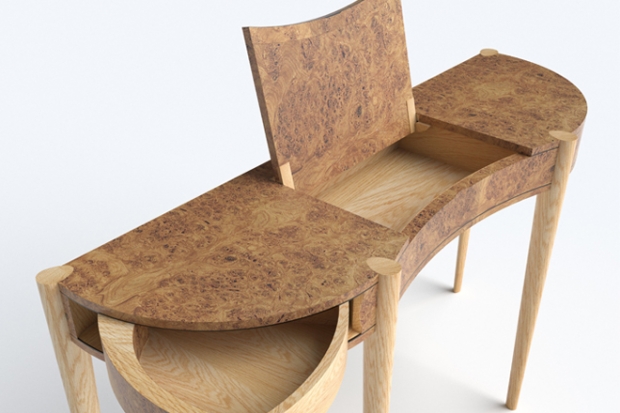
Crafted from high quality timber and finished with delicate white paint, the new collection of painted wooden beds for children includes bunk beds, day beds and guest beds. One of the highlights of the range is Pulka, an elegant single sleigh design with a pull-out guest bed and three storage drawers. Suitable for adding traditional charm to children’s rooms, Pulka features authentic sleigh styling such as roll-top edges and softly curved head- and foot-ends.
The pull-out guest bed underneath is easy to manoeuvre thanks to a raised edge, and comfortably fits a full-size single mattress, with room for a duvet cover and pillows. Integrating three roomy storage drawers into the pull-out base, Pulka makes the most of the space in smaller rooms. “Drawing inspiration from classical designs, Pulka brings a touch of nostalgia to children’s bedrooms and is the kind of style that will never date,” says MD Zed Hyder.
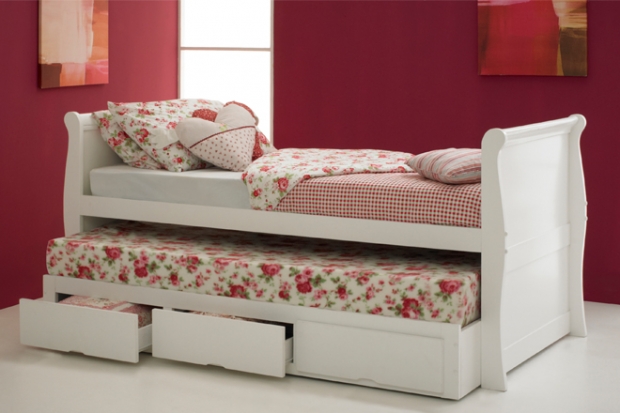
The Sophia range is a French style furniture range from Crown French that is made from solid beech and finished bespoke to customer choice. The Sophia range is on display to the public in Crown French's store in Nottingham.
Every piece of the range is hand-finished in the UK, and is available to the end consumer at a sensible price. What is more, the Sophia bed has one fixed price which is the same for all sizes from double to super king.
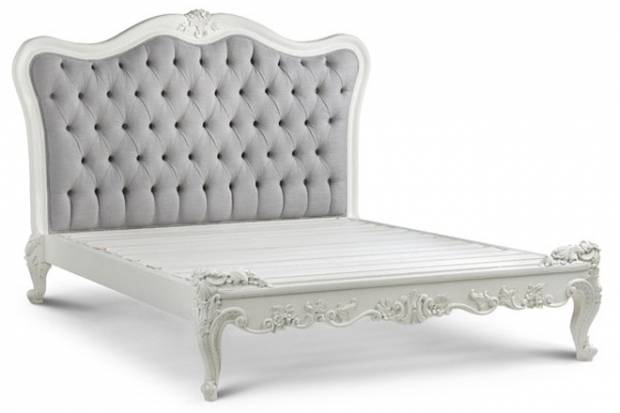
From 7 to 10th September, the September edition of the China International Furniture Fair, will present CIFF Outdoor & Leisure 2016, a platform specialising in outdoor furniture and that offers a wide range of products to meet the needs of those spending time outdoors.
At CIFF Outdoor & Leisure the major Chinese brands will propose innovative furnishing systems for the garden, and the most suitable equipment for leisure activities. Furthermore, buyers can find and purchase outdoor and leisure products from the largest industry-based furniture fair in China.
The best of Chinese outdoor products will therefore be on display at the National Exhibition & Convention Center (Shanghai) of Hongqiao, focusing heavily on product design, quality and also sustainability.
The garden furniture product range displayed at CIFF-Shanghai is completed and enriched with furnishing themes in order to give the visitor an overall view of this unique and intriguing sector. So, in Pavilion 5.1, all the aspects associated with the garden and free time will be tackled, ranging from wooden sheds to sun awnings and sun-blocking systems, from gardening equipment to camping gear and apparatus for cooking outdoors.
30,000 square metres of surface area will be occupied by more than 150 brands, proof of the fact that CIFF is the largest Chinese platform for the sector; large companies, which invest heavily in order to be competitive on the internal market, and also on the international markets.
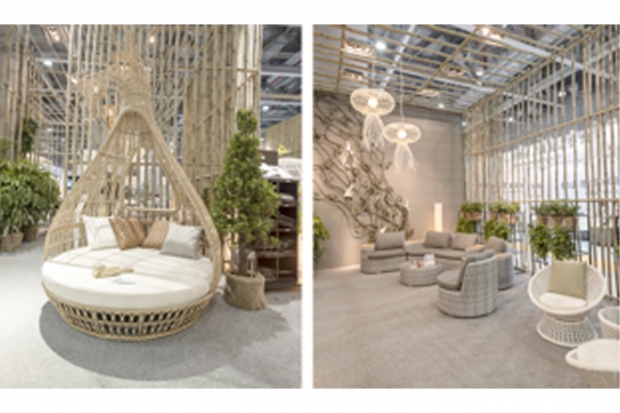
The furniture manufacturing industry in the UAE has witnessed steady growth, given the pace of economic development, population growth and the corresponding rise in housing facilities.
According to the latest figures from the Ministry of Finance and Industry, the number of furniture manufacturing establishments increased by 36.7 per cent from 158 in 1998 to 216 in 2000.
The accompanying labour growth showed a 35.3 per cent rise, from 7,955 workers in 1998 to 10,763 in 2000. Also, capital invested grew by 46.1 per cent from Dh326.61 million to Dh477 million.
While the number of establishments increased at an average annual growth rate of 10.9 per cent, the number of employees grew by an average annual growth rate of 10.6 per cent, and the total invested capital rose by 13.5 per cent per annum. This reveals that the scale of production has been growing at a greater rate than the expansion of the industry.
 |
The geographical distribution of factories, labour and capital: In 2000, furniture business was concentrated in Sharjah, numbering 100 factories, which is 46.3 per cent of the total 216 factories operating.
Dubai ranked next with 82 factories and 38 per cent of the total, while Ajman was placed third, with a share of 10.6 per cent and 23 factories. The other emirates together accounted for 5.2 per cent of the number of factories.
Similarly, 49.6 per cent of the labour force, or 5,339 staff, were employed in Sharjah; Dubai factories employed 3,681 while Ajman's share was 1,249 employees or 11.6 per cent. Factories operating in Abu Dhabi, Ras Al Khaimah, Umm Al Quwain and Fujairah hired 4.7 per cent of the total labour, with 497 employees.
Some 57.2 per cent of the total capital invested worth Dh273 million, was in Sharjah; 30.4 per cent, or Dh145 million in Dubai; 4.4 per cent or Dh 21 million in Ajman; and 5.5 per cent worth Dh 24 million, was in Abu Dhabi.
The geographical distribution of factories has been influenced by the facilities that each emirate grants to investors and the economic policy of each emirate. Sharjah, Dubai and Ajman offer more facilities to investors in this sector and as such lower the operation costs of such capital-intensive industry to attract more players and expand the manufacturing sector.
It is important to note that the industry made strides in Abu Dhabi, with the number of factories doubling from two in 1999 to four in 2000 and the labour numbers growing by 251 per cent, from 64 employees in 1999 to 225 in 2000. Also, the amount of capital invested in these factories increased eight times from Dh3 million in 1999 to Dh24 million in 2000.
Although there were three factories in Ras Al Khaimah hiring 201 employees, the amount of capital invested in 2000 was Dh11 million. Also, three factories in Umm Al Quwain had 54 employees and a capital of Dh2 million. This reveals that the factories operating in Ras Al Khaimah operated on a larger scale than those in Umm Al Quwain.
 |
A comparison of the figures for Abu Dhabi, Ras Al Khaimah and Umm Al Quwain revealed that Abu Dhabi factories have larger operations and the operating costs there are greater than both Ras Al Khaimah and Umm Al Quwain.
Abu Dhabi's furniture trade: The expansion of Abu Dhabi's furniture manufacturing sector has led to increased trade of furniture. Hence imports increased by 19 per cent from 9.1 million kilos in 1999 to 10.9 million kilos worth Dh180.1 million in 2000.
Re-exports rose from 41,690 kilos in 1999 to 141,735 kilos. And exports increased by 6 per cent from 92,341 kilos worth Dh1.2 million to 97,885 kilos worth Dh1.7 million.
While imports accounted for 97.9 per cent of total furniture trade, re-exports accounted for 1.3 per cent and exports for 0.9 per cent.
The Department of Ports and Customs has classified furniture under three categories: seats, which include all types of wooden and metal seats as well as related parts; mattresses, which include all types of mattresses, pillows, cushions, covers and the like; and other furniture, which includes wooden and metallic household and office furniture.
During 2000, the import of other furniture accounted for 90.5 per cent (9.9 million kilos worth Dh157.1 million), while seats accounted for 5.9 per cent (0.6 million kilos worth Dh15.2 million) and mattresses for 3.6 per cent (0.3 million kilos worth Dh8.3 million).
The export of other furniture accounted for 67.4 per cent (worth Dh1.2 million), while mattresses accounted for 26.4 per cent and seats accounted for 6.1 per cent. Re-export of other furniture accounted for 95.9 per cent (0.13 million kilos) while seats accounted for 2.4 per cent (3,372 kilos) and mattresses for 1.7 per cent (2,376 kilos).
Main places that Abu Dhabi imports seats from are Malaysia, Spain and Italy. Other furniture is imported from Denmark, Italy, Spain, Japan and other countries. Mattresses are imported from Saudi Arabia, Kuwait, Italy, Germany and others.
The main destinations that seats are re-exported to are UK, Spain, Saudi Arabia and Egypt.
Mattresses are re-exported to Lebanon, Kuwait and Jordan, among other countries. And other furniture is re-exported to Saudi Arabia, Kuwait, Germany, Indonesia, Jordan, Canada and other countries. Mattresses are exported to Saudi Arabia and seats are exported to Bahrain. Other furniture is exported to India, Lebanon, Philippines, U.S., and Bahrain.
Dubai's furniture trade: With the expansion of Dubai's furniture manufacturing sector, the emirate has witnessed major trade volumes.
Latest figures given by the Dubai Chamber of Commerce and Industry and the Department of Ports and Customs showed a high growth during the past eight years, with imports rising from 34,417 tonnes in 1991 to 54,685 tonnes in 1995 and 81,813.6 tonnes in 1999 at an average annual growth rate of 10.1 per cent.
Exports grew by 1.7 per cent per annum, from 2,660 tonnes in 1991 to 3,022 tonnes in 1995 and 3,086.9 tonnes in 1999. Re-exports rose at an average annual growth rate of 12.9 per cent, from 5,347 tonnes in 1991 to 10,198 tonnes in 1995 and 15,909.5 tonnes in 1999.
With this constant increase, the value of imports has gone up by 89.5 per cent from Dh390.8 million in 1991 to Dh740.8 mill
The Association of Master Upholsterers & Soft Furnishers (AMUSF) has joined The Furniture Ombudsman (TFO) as an affiliate member, to pledge its ongoing commitment to helping the industry improve.
This means AMUSF is continuing to raise standards and the organisations are committed to sharing knowledge, pulling expertise and working on initiatives that will help businesses and consumers.
The AMUSF was founded in 1947 to protect the interests of upholsterers, small furniture makers, and soft furnishers. Since then, the association has vastly extended the range of support it gives to members. It is still a lobbying body but it also provides diverse services to individual members including advice on sourcing materials, a technical help line including the current fire regulations, a group buying scheme, a free legal help line and many others.
TFO has a pool of members which extends to approximately 8000 furniture and home improvement outlets in the United Kingdom. All of its full members pledge to abide by a Code of Practice which bestows additional rights on the consumers who shop with them. Most of the UK's biggest furniture and home improvement retailers pledge their support for the scheme.
Richard Ranklin, association manager, says: “We are delighted to have formally linked up with the TFO. This partnership not only ensures we have access to help and advice for our members on trading and consumer issues that arise but has the bonus of that advice coming from a body built around our industry. The TFO has unrivalled experience in the furnishings industry and to be able to call on that will undoubtedly be beneficial to all our members.”
Kevin Grix, chief ombudsman and chief executive of The Furniture Ombudsman, says: “We recognise that furniture making is not all done in warehouses with the support of technology and optimised operations and we are keen to engage more and more with the sole traders and craftsmen in England. We are proud to have joined a partnership with AMUSF and hope to better understand the challenges faced by the upholsters in the industry, and then support them in raising their standards, and therefore inspiring consumer confidence.”
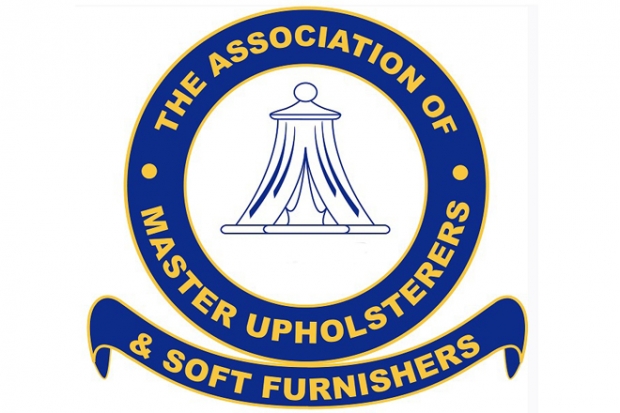
For all the anti-trade sentiment being voiced in the presidential campaign, particularly against China and Mexico, you would think that furniture imports would be down, or flat at best.
Yet consumers continue to vote with their dollars by purchasing furniture made not only in China and Mexico, but also Vietnam, Canada, Italy and Indonesia to name several.
More details on those shipments will follow in future posts. We’ll also have a comprehensive overview of imports and exports for the first half in our market issue for opening day.
It’s obviously true there is a renewed interest in made in America. It's a trend we are glad to see as it supports good paying manufacturing jobs here in the U.S.
But those products often come at much higher price points. When it comes to affordable, well-made furniture, including case goods in improving multi-step finishes, imports continue to gain ground.
Will the industry benefit from the anti free-trade sentiment being expressed in certain political circles? And will the jobs come back as promised?
The death knell of the 90-degree angle in furniture design continues to ring.
Spanish designer Jaime Hayon has teamed up with Austrian furniture company Wittmann on a collection of seating and tables that fuses classic clean lines with the au courant, ‘70s-style rounded edges we’ve seen sprout up at festivals and design fairs in the last couple of years. Dubbed “Workshop,” the line includes a sofa and lounge chairs—named “Vuelta”—and side tables, including the “Grain Cut Side Table,” drum-like leather side tables that balance on three legs, and “DD,” taller, two-tiered tables made of metal and marble.

The seating—which includes a modern take on the traditional wingback chair—comes in both fabric and velvet upholstery, in a number of hues—many seemingly ‘70s inspired—including mustard, deep red, and navy. Hayon and Wittmann cite Austrian Vienna Secessionist architect and designer Josef Hoffmann as a source of inspiration; the “Workshop” collection riffs on the twentieth-century architect’s affinity for luxe materials and rounded geometries in his own work.


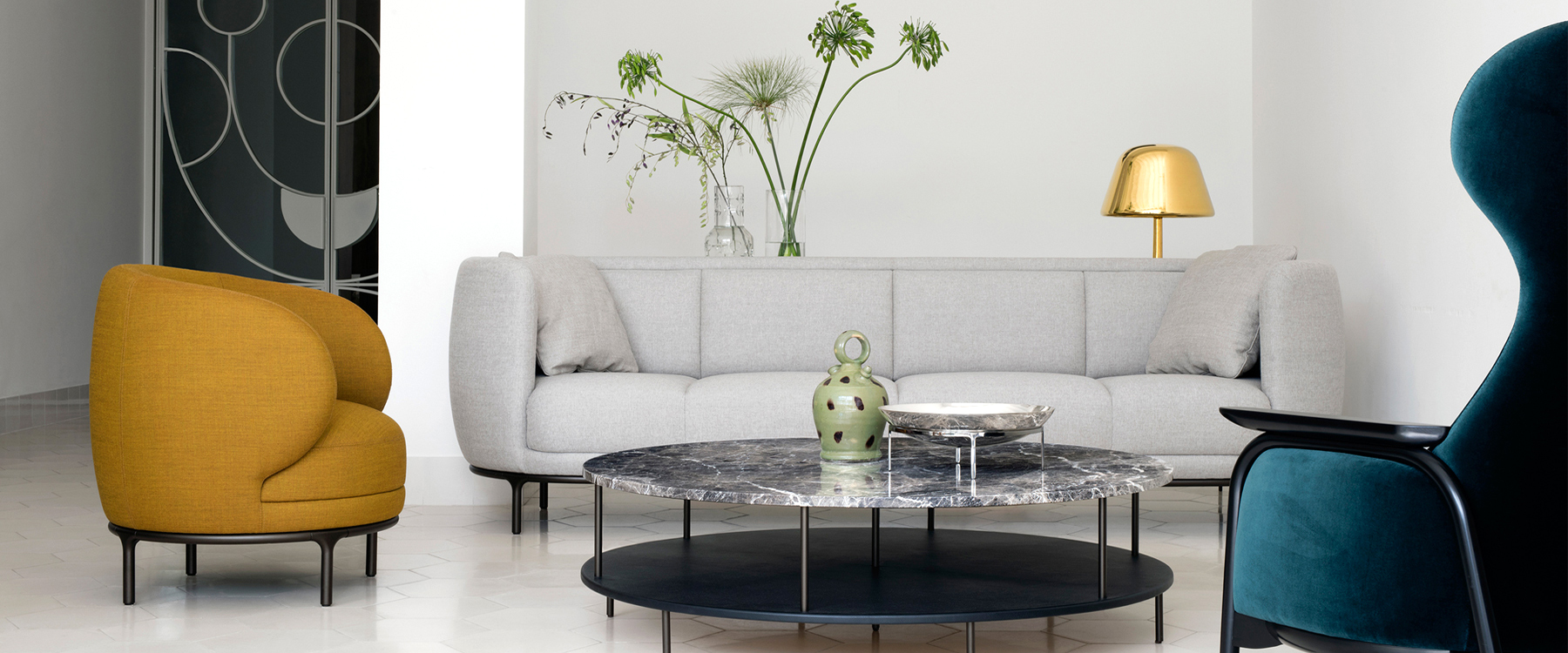
Furniture companies in the UK are upping sticks and moving to the Republic to circumvent strict new copyright laws introduced there which have – almost overnight – rendered it virtually impossible to make and sell replicas of design classics for up to 70 years after a designer’s death.
However such companies’ time here may be brief as businesses lobbying hard to keep the work of acclaimed furniture designers under copyright for longer look set to replicate legal moves in the UK by threatening court action here in order to force for the State to comply with an EU directive on copyright infringement.
The new rules in the UK have extended design rights to works created after 1957 from 25 years after their launch to a full 70 years after the designer’s death.
Another law under consideration in the UK at present would see iconic pre-1957 designs also fall under copyright protection and make it an offence to incorporate any element of particular products into new pieces without a licence.
While the rule changes are intended to protect designers or their estates, anyone looking to get faux-designer pieces on the cheap in the future may struggle and even interiors magazines might be hit with hefty fees if they print pictures of items protected by the laws without a licence.
One furniture company which has already moved to the Republic trades under the name Voga. It is based in Kildare and was prompted to move across the water because of the change to the British Copyright, Designs and Patents Act this summer which has made it illegal to sell replicas of iconic designs without acquiring an expensive licence.
Amongst its best sellers are chairs “inspired by” acclaimed furniture designers Charles Eames, Arne Jacobsen and Poul Henningsen. Jacobsen’s iconic Egg Chair has a retail price on the site of €799 compared with in excess of €9,000 for an original piece.
An Eames Lounge chair – which has turned 60 this year – would sell for close to €4,000 were it original but a replica can be bought for €895 on the site, while an artichoke lampshade by Henningsen that normally sells for more than €6,000 can be bought for no more than €370.
The company’s business model is to sell copies of classic designs for a whole lot less than full price and it now describes itself on its website as an Irish company. Under the law here it is “able to reproduce designs and sell replica furniture 25 years after its initial creation, which is exactly what we do. As a result, we comply fully with Irish law, making it perfectly legal to buy beautiful furniture from Voga.”
It also tells would-be customers from outside of this jurisdiction that it “is still 100 per cent legal to buy and import our products from our warehouse in Ireland, even if the copyright law in your country differs to that in Ireland. This is because you are not infringing any exclusive rights under local copyright regulation in other EU/EEA countries when you are buying replica furniture.”
So by basing itself in Kildare it can legally sell replicas to UK customers although customers do have to arrange for delivery to ensure they are not breaking the law.
The rule change in the UK was brought about as a result of a fierce lobbying effort led by Swiss design company Vitra which fought for UK copyright laws to be aligned with a 1998 European design directive that protects mass-produced furniture in the same way as as books, music and photography.
Vitra owns the distribution rights for original Herman Miller creations, including the Eames lounge chair and it claims the cheap replica market has cost it €250 million a year in the UK alone in lost profits.
The British Intellectual Property Office (IPO) initially planned to have a law come into force in 2020 to allow companies sell affected stock they already held without fear of penalties but Vitra successfully pushed for the law to be changed faster.
When the IPO fast-tracked the changes Vitra hailed it as a victory for the design industry. “We welcome the decision of the British government which mandates that artistic designs will soon fall under the same copyright protection in the UK as they do in other European countries.”
“This is long overdue in Ireland and I think we need change the copyright laws as soon as possible to better protect both designers and consumers ,” said retail and interior designer Helen Kilmartin who owns Minima, an interior design consultancy and store that represents many of the world’s leading furniture, lighting and home accessories brands, including Vitra. That Eames lounge chair is available from Minima which sources directly from Vitra. The price is not listed.
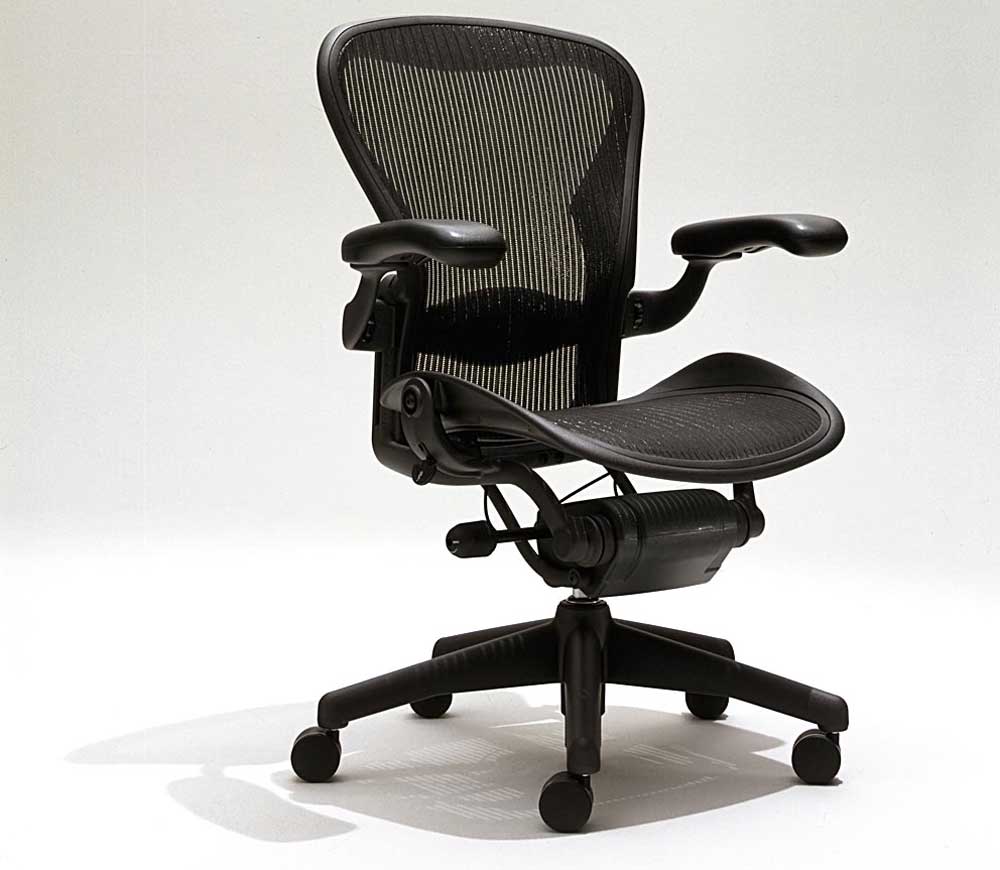
Global OConnect, an unprecedented cross-border e-commerce platform committed to connecting global businesses with China, is launching the Foshan Household Essentials (FHE) brand experience center in Tehran, Iran from September 25 through December 25, taking a major step to introduce Chinese companies to Iran to explore further business opportunities.
With a total area of 5,200 square meters, the center is hosted at Behnoush Building, 9km Jade Makhsos Karaj, Kheyabane Shahid Mohammad Pur in Tehran to display a wide array of household essentials from Foshan, among which the general Foshan furniture industry’s brand presentation will last one year.
The endeavor is part of Global OConnect’s grand plan to bring business opportunities and partnerships for Chinese brands in Iran and the Middle East, with an aim to change how Iranians think of “made-in-China” products in the past as cheap and low quality by introducing the new, best quality products and brands from China.
The FHE will facilitate both online and offline events to highlight China’s furniture manufacturing base and Foshan’s booming household essentials businesses. The three-month exhibition will feature 19 top Foshan furniture companies including Foshan Qixin, Dongmin and Qi He Furniture Company, 12 leading ceramic companies such as Monalisa Group, Foshan Dongpeng Ceramic Company and Foshan Nanhai Sannora Sanitary Ware Company, as well as 32 major household appliance companies including Midea, Galanz and Foshan EPDA Electronic Technology Company, all internationally-acclaimed brands that can represent the high-quality of “New Made-in-China” products.
“Foshan has gained strategic advantages that are supported by a whole industry chain, rich resources and innovative thinking. Through introducing products of quality from Foshan, we want to reverse the stereotype of China products that are cost effective and present a new image of Chinese brands to the Iranian market through our groundbreaking e-commerce platforms that combine online business with showroom displays,” said Kevin Fenn, founder and Chairman of Global OConnect.
This win-win China-Iran partnership in the furniture industry paves the way for leading Chinese industries to research the Iranian market. It is also a milestone in China-Iran cooperation in trade and the economy, a mutually beneficial collaboration that introduces high standard industries from China and encourages Chinese manufacturers to seek opportunities globally.
With Guangdong Province signing an agreement to expand cooperation with Qeshm Island, one of Iran’s free trade zones, earlier this year, Global OConnect’s innovative foreign trade platforms will further develop individualized plans for Foshan and more of China’s competitive industries to enter the emerging markets in Iran and the Middle East by integrating all resources of logistics, custom clearance, payments, localized legal, branding, market survey and other services to provide comprehensive solutions for Chinese companies to promote their businesses and to develop future investment plans.
The second largest economic power in the Middle East after Saudi Arabia, Iran is fully recovering from recently-lifted economic sanctions and has great market potential. Trade between China and Iran presents an unprecedented opportunity. Global OConnect will not only bring investments and create more job opportunities in Iran and the Middle East in this context, but also establish new trade and investment landmark in the dynamic and promising regions.